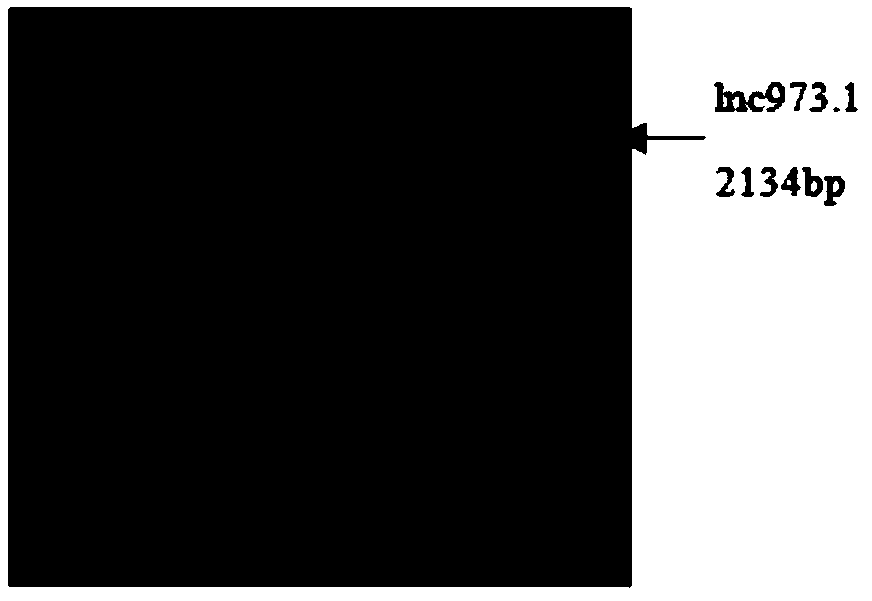Cotton long non-coding RNA-lnc973 and application thereof in plant salt tolerance
A long-chain non-coding, salt-tolerant technology, applied in the field of molecular biology, can solve problems such as influence regulation, and achieve the effect of improving salt-tolerance and wide application value
- Summary
- Abstract
- Description
- Claims
- Application Information
AI Technical Summary
Problems solved by technology
Method used
Image
Examples
Embodiment 1
[0039] Example 1: Detection of the expression level of lncRNA-lnc973
[0040] 1. Materials and Reagents
[0041] 1.1 Materials
[0042] The cotton used in this experiment is G. hirsutum L., a salt-tolerant cotton line Shannong 91-11 (untreated material is denoted as S_CK, 250mmol / L NaCl-treated material is denoted as S_NaCl).
[0043] 1.2 Reagents
[0044] The RNAprep Pure Plant Kit was purchased from Beijing Tiangen Biotechnology Co., Ltd.; the reverse transcription kit (RR047A) and qRT-PCR kit (RR420A) were purchased from Baoriyi Biotechnology (Beijing) Co., Ltd.; primers were provided by Sangon Synthesized by Bioengineering (Shanghai) Co., Ltd.
[0045] 2. Experimental method
[0046] 2.1 Transcriptome sequencing of lncRNA
[0047] Using untreated cotton and cotton samples treated with 250mmol / L NaCl for 24 hours as objects, RNA-seq was entrusted to Beijing Annoroad Gene Technology Co., Ltd. to conduct. Total RNA was isolated from each cotton seedling sample using RNA...
experiment example 2
[0065] Experimental example 2: Cloning and analysis of lncRNA-lnc973 sequence
[0066] 1. Reagents and carriers
[0067] Reverse transcription kit PrimeScript TM 1st Strand cDNA Synthesis Kit, restriction endonucleases Kpn Ⅰ, Pst Ⅰ, cloning vector pMD19-T and DNA A-Tailing Kit were purchased from Baori Medical Biotechnology (Beijing) Co., Ltd.; high-fidelity enzyme 2× Max Master Mix was purchased from Nanjing Nuoweizan Biotechnology Co., Ltd.; Universal DNA Purification and Recovery Kit (DP214) and Plasmid Mini-Extraction Kit (DP103) were purchased from Tiangen Biochemical Technology (Beijing) Co., Ltd.
[0068] 2. Method
[0069] 2.1 Extraction of total RNA
[0070] The experimental method was the same as 2.2.1 total RNA extraction in Experimental Example 1.
[0071] 2.2 Primer design
[0072] According to the sequence (SEQ ID NO.1) of lncRNA-lnc973 nucleotide, lncRNA-lnc973 amplification primers were designed by Primer premier 5.0 software, specifically as follows: ...
experiment example 3
[0089] Experimental Example 3: Verification of Transgenic Function—Arabidopsis Transformation, Screening and Phenotypic Analysis of Salt Tolerance
[0090] 1. Arabidopsis planting and pre-transformation treatment
[0091] Sprinkle the wild-type Arabidopsis evenly on the seedling tray, and when it grows to four leaves, transplant it into the nutrient pot (mix the nutrient soil and vermiculite in equal proportions), cultivate it at 23°C, and light it for 16 / 8h. cycle. When the lateral moss inflorescences of the plant form flower buds and partly bloom or form 1-2 siliques, they can be used for transformation, and the bloomed flowers and grown siliques need to be cut off before transformation.
[0092] 2. Transformation of Arabidopsis
[0093] Pick the activated monoclonal positive Agrobacterium GV3101 strain containing recombinant plasmid pCAMBIA1300-lnc973-eGFP to 5ml fresh LB liquid medium (containing Kan + and Rif + ), shake culture at 28°C for 24 hours to obtain the bacte...
PUM
 Login to View More
Login to View More Abstract
Description
Claims
Application Information
 Login to View More
Login to View More - R&D
- Intellectual Property
- Life Sciences
- Materials
- Tech Scout
- Unparalleled Data Quality
- Higher Quality Content
- 60% Fewer Hallucinations
Browse by: Latest US Patents, China's latest patents, Technical Efficacy Thesaurus, Application Domain, Technology Topic, Popular Technical Reports.
© 2025 PatSnap. All rights reserved.Legal|Privacy policy|Modern Slavery Act Transparency Statement|Sitemap|About US| Contact US: help@patsnap.com



